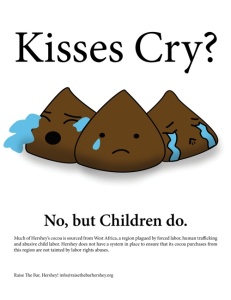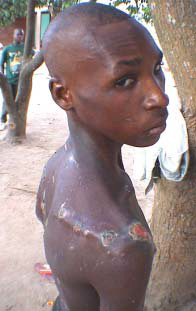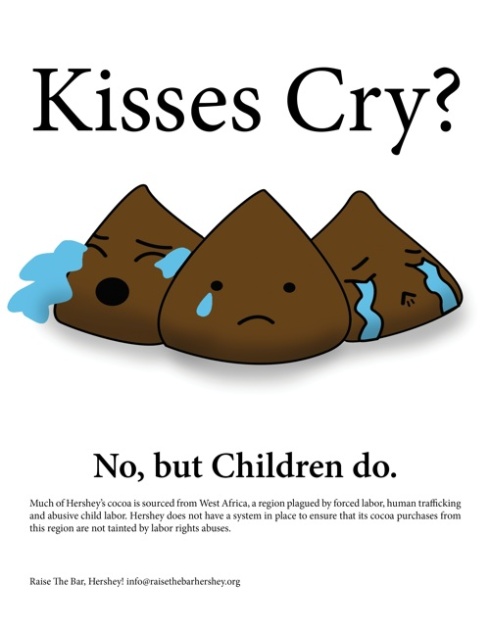FUN SIZE?

(Updated September 30, 2015)
A new class action lawsuit was filed Monday against Hershey, Mars and Nestle alleging the companies are guilty of false advertising for failing to disclose the use of child slavery thereby deceiving consumers into unwittingly supporting the child slave trade.
A documentary (Slavery, A Global Investigation) released in 2000, quotes one of the child slaves:
“Asked what he’d say to the billions who eat chocolate worldwide (most of the boys have never tried it), one boy replies: “They enjoy something I suffered to make; I worked hard for them but saw no benefit. They are eating my flesh.”
The boys’ stories are sickeningly graphic. Before beatings, the boys say they were stripped naked and tied up. They were then pummeled with a variety of weapons, from fists and feet to belts and whips.
THIS HALLOWEEN DON’T LET YOUR KIDS ACCEPT CANDY MADE BY CHILD SLAVES
SPEAK WITH YOUR DOLLARS AND DON’T BUY CANDY FROM COMPANIES THAT FAIL TO ADHERE TO INTERNATIONAL LAW AND THAT STILL USE CHILD SLAVERY IN THEIR CANDY SUCH AS HERSHEY’S, NESTLE, MARS, WHOPPERS, REESES, KIT-KAT’S AND ANY COMPANY WITHOUT THE FAIR TRADE LABEL


Cocoa’s first consumers are chocolate companies, which could clean up the industry by refusing to buy beans produced by children.
The International Labor Rights Forum (ILRF) has a scorecard to assess the progress companies are making in their alleged efforts to stop exploiting child labor. It shows that if chocolate-makers had the same motivation to make chocolate as they are in fighting child slavery, the industry would have crumbled long ago.
Although the battle began in 2001, Hershey “continues to drag its feet in dealing with child and trafficked labor in its supply chain,” reports ILRF. “Like Mars and Nestle, Hershey has not effectively produced transparency or accountability…”
Nestle has been a main target of reformers because “unlike other chocolate manufacturers Nestle directly sources cocoa from West Africa and has direct control over its supply chain…” says ILRF.
http://www.viewzone.com/chocolarte.html
Update
September 30, 2015.
Lawsuit: Your Candy Bar Was Made By Child Slaves
A lawsuit filed Monday alleges that some of the world’s largest chocolate makers are knowingly using child labor in Africa.
The Milton Hershey School in Pennsylvania is one of the wealthiest education centers in the world. Founded in 1909 as an orphanage for “male Caucasian” boys, it was awarded 30 percent of the company’s future earnings by Milton S. Hershey upon his death. Thanks to the success of Kit-Kats, Reese’s, and Whoppers, the school is worth a staggering $7.8 billion.
Now home to more than 2,000 students, it owns a controlling interest in the $22.3 billion Hershey company—a chocolate maker with roots in child protection and education that, in the worst form of irony, allegedly relies on cocoa harvested by child laborers in West Africa.
It is this irony that serves as the motivation behind a class action lawsuit filed Monday against Hershey and two of its competitors, Mars and Nestle. The complaints, filed by three California residents, allege that the companies are guilty of false advertising for failing to disclose the use of child slavery on their packaging. Without it, the plaintiffs claim, the companies are deceiving consumers into “unwittingly” supporting the child slave labor trade.
“America’s largest and most profitable food conglomerates should not tolerate child labor, much less child slave labor, anywhere in their supply chains,” the complaint reads. “These companies should not turn a blind eye to known human rights abuses… especially when the companies consistently and affirmatively represent that they act in a socially and ethically responsible manner.”
The class action suits seek both monetary damages for California residents who have purchased the chocolate and revised packaging that denotes child slaves were used. It’s a new approach to an old problem; the chocolate industry’s deep, dark, not-so-secret scandal. It’s been 15 years since the first allegations of child slavery in the chocolate industry caused national outrage. Will this be the final straw?
West Africa is home to two-thirds of the world’s cacao beans (cocoa), the main ingredient in chocolate—a product that’s fueled a $90 billion industry.
The first group to question the financial strategies behind the industry’s wealth was a British organization called True Vision Entertainment. In a shocking 2000 documentary titled Slavery: A Global Investigation, the group reported on the chocolate industry’s alleged connection to cocoa harvested by child slaves. The award-winning film opens on stick-thin adolescent boys in the Ivory Coast slinging hundred-pound bags of cocoa pods on their backs, followed by an interview in which the boys express their confusion over not being paid.
Later the filmmakers meet with 19 children who were said to have just been freed from slavery by the Ivorian authorities. Their guardian describes how they worked from dawn until dusk each day, only to be locked in a shed at night where they were given a tin cup in which to urinate. During the first six months (the “breaking-in period”), they say, they were routinely beaten. “The beatings were a part of my life,” says Aly Diabata, one of the former child laborers. “I had seen others who tried to escape. When they tried, they were severely beaten.”
The boys’ stories are sickeningly graphic. Before beatings, the boys say they were stripped naked and tied up. They were then pummeled with a variety of weapons, from fists and feet to belts and whips. In the film, some of the boys get up and imitate the beatings. Others stand to reveal hundreds of scars lining their backs and torsos—some still bloody and scabbed. They get quiet when the filmmakers ask whether any are beaten today and say some are simply “taken away.”
Asked what he’d say to the billions who eat chocolate worldwide (most of the boys have never tried it), one boy replies: “They enjoy something I suffered to make; I worked hard for them but saw no benefit. They are eating my flesh.” Toward the end of the segment, the filmmakers meet with one of the “slave masters,” who admits he purchased the young boys and that some of his men routinely beat them. His reasoning: He is paid a low price for the cocoa and thus needs to harvest as much of it as he possibly can.
The release of the film in late 2000 sparked national outrage. No one seemed more shocked than the chocolate companies themselves. In June 2001, Hershey senior vice president Robert M. Reese told Philadelphia Inquirer reporter Bob Hernandez that “no one, repeat, no one, had ever heard of this.” After internal investigations, several companies, including Hershey, expressed concern over the conditions of laborers in West Africa.
The news made its way to Congress, where U.S. Rep. Eliot Engel quickly drafted legislation asking the Federal Drug Administration to introduce “slave free” labeling. After gaining approval in the House of Representatives, the bill moved to a vote in the Senate, where it had the support needed to win passage. But just before the legislation made it to a vote, the chocolate industry stepped in with a promise it has yet to keep: to self-regulate and eradicate the practice by 2005.
The Engel-Harkin Protocol (or Cocoa Protocol), as the agreement was called, was signed in September 2001.
Eight companies—including Nestle, Mars, and Hershey—were signatories of the massive accord, pledging $2 million to investigate the labor practices and eliminate the “Worst Forms of Child Labor,” the official term from the International Labor Organization, by 2005. When the July 2005 deadline arrived with the industries yet to make major changes, an extension was granted until 2008.
CANDY MADE BY CHILD SLAVES-The Daily Beast








